Winter hiking can be intimidating for beginners. Although I’ve been hiking pretty regularly since about 2010, I didn’t go on my first winter hike until 2018. I thought it would be windy, cold, and generally unpleasant. I love the feeling of warm sun on my skin as I lay across the warm rocks on a well-earned summit. I thought winter hiking would be just awful.
I couldn’t have been more wrong.
Winter hiking is a wonderland. The pines are draped in snow, the ice is shaped into a million intricate sculptures, and the entire world is turned into a majestic landscape like something out of a dream. On top of all that, there are way fewer people out, so you may get the summit to yourself.
Winter hiking is amazing. But, more than at any other time of year, it is imperative that you go prepared. Winter is a volatile season in the mountains and it can be dangerous. Preparation is key and safety should always be your top priority. If you take the proper precautions, winter hiking can be one of the most amazing experiences you’ll ever have in the mountains. Even as a beginner.
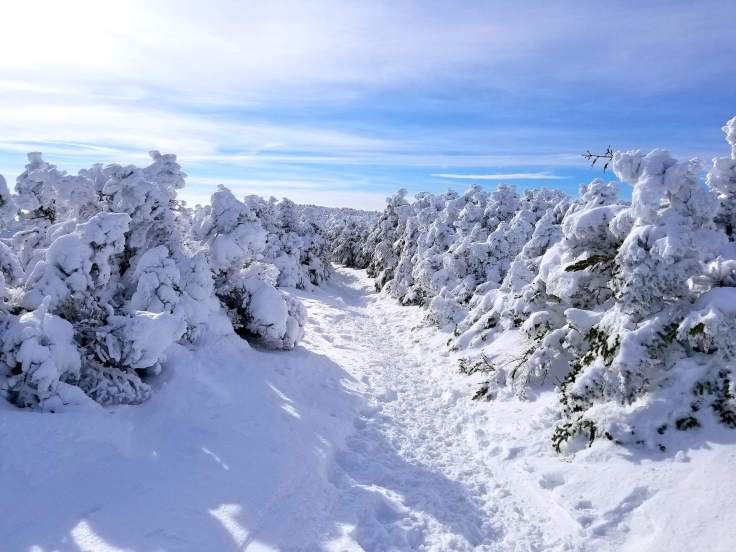
Winter Hiking for Beginners: Before You Go
There are a few key things that beginners ought to keep in mind as you start to plan your first winter hike. First, don’t hike alone! If you’re used to hiking solo in the spring, summer, and fall this can be a tough pill to swallow—but winter hiking is dangerous! Hike with a buddy for your first winter season until you learn how to adapt to the changing landscape. You can find hiking groups on facebook or places like meetup.com if you don’t have any hiking buddies.
Second, know your route. I realize this is also true during the warmer months, but it is so much easier to get lost in the winter. You could be hiking an unbroken trail, an unexpected whiteout could hit, or you could lose the trail when hiking above the tree line. More than ever, when winter hiking as a beginner you need to know the names of the trails, have a map, and be ready to use it.
Third, be prepared for any conditions. On a single winter hike, the weather could change from bright, sunny, and above freezing, to windy, snowing, and dangerously cold. Come prepared with the gear you need to face any weather, not just what the forecast reads.
And on that note, let’s get to the good stuff…
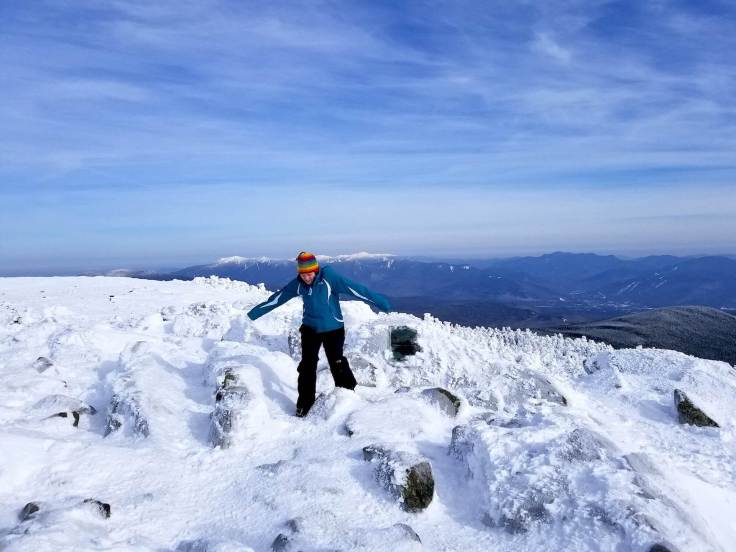
What to Wear Hiking in Cold Weather
The key to hiking in the winter is wearing layers! You want to ensure that you don’t sweat on the way up. If you sweat, your clothes will get wet and you run the risk of frostbite. Wear clothing that breathes well and wicks away moisture. Stay away from cotton. Once wet, it will never dry. Instead, try packing winter gear like this:
- Base Layer shirt and pants made of a thin, breathable, synthetic material.
- Warm second layer like a fleece shirt and thicker leggings.
- Down jacket with detachable outer shell like this North Face jacket.
- Insulated snow pants
- Insulated tall socks and sock liners
- Glove liners and insulated mittens (I prefer mittens to gloves for my outer hand layer as they retain heat better).
- Insulated hat.
- Insulated hiking boots. I wear Salomons.
- Gaiters (if your snow pants don’t include them).
- Sunglasses or ski goggles
- Balaclava or other face cover
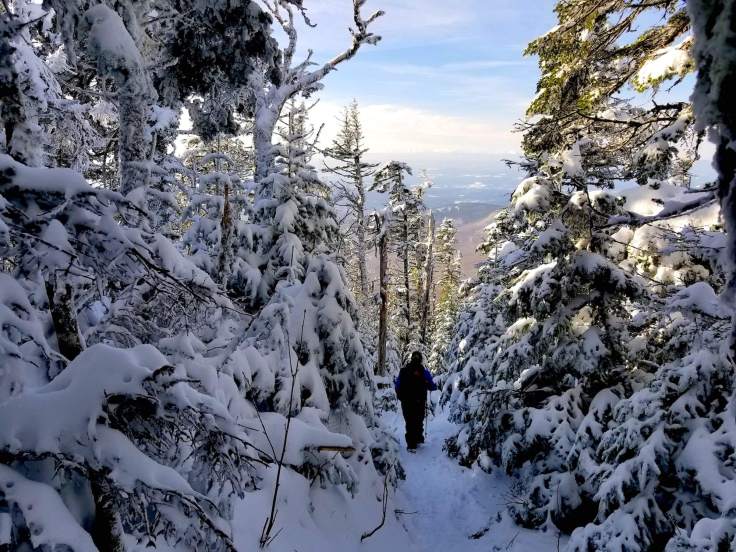
What Gear to Pack for a Winter Hike
Because you need to be prepared for several different situations on any one hike, winter hiking can require a lot of gear. Finding friends or groups to hike with can help offset the cost, as can renting some gear, such as snowshoes, for the first season if you can’t afford all the gear up front.
But, to be properly prepared for a winter hike, I recommend packing the following gear:
- Map + Compass (and know how to use them)
- Snowshoes and microspikes/hillsounds – be ready to need both depending on conditions.
- Water in insulated containers. Choose water bottles over bladders as the tube can freeze too easily. Bring hot water in a thermos.
- Small stove and pot for boiling snow, especially on very long or very cold hikes.
- Hand Warmers – these are useful for keeping extremities warm. But also keep one in your pack near your phone to save battery life. If you want to be environmentally conscious, I recommend getting some reusable hand warmers.
- Flashlight – even on a day hike it gets dark fast in the winter.
- Hiking Poles
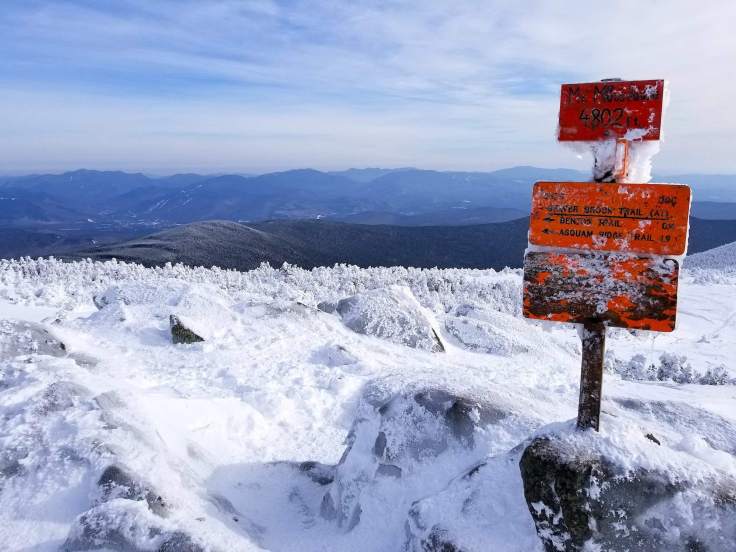
What To Wear On Your Feet
This is the big question and a source of major debate among winter hiking enthusiasts. But if we rule out skiing/boarding for now, on the day of your hike you have three choices for footwear.
- Snowshoes: No matter what the conditions, you should always bring snowshoes with you. When there is recent snow on the trail or lots of snow, you’ll want to use your snowshoes. It’ll make it easier for you to walk, and help preserve trail conditions for other hikers.
- Microspikes/Hillsounds: If snow cover is thin or you expect the trail to be hard packed and maybe a bit icy, microspikes or hillsounds are the way to go. These smaller spikes help you grip the snow and prevent you from slipping as you walk.
- Crampons: These larger spikes are necessary when the trail is extra steep or icy, or if you plan to descend down a steep rock face during your hike. The long spikes help you secure your footing and prevent injury.
As always, no matter which of these options you choose, you’ll want to wear a pair of insulated winter hiking boots.
What Food to Bring on a Winter Hike
Winter hiking uses up more energy than warm weather hiking because your body is working overtime to keep you warm. Because of this, you need to eat plenty of high calorie food to keep your metabolism and your body temperature high. Some snacks I recommend are:
- Nuts and dried fruit
- Candy (Snickers is my favorite hiking candy).
- A thermos of hot cocoa
- Protein bars
Whatever food you like to eat on a hike, bring lots of it and eat! You’ll be very cold by the end of your hike if you neglect your nutrition. Eat a lot and keep warm.

Winter Hiking Can Be Awesome for Beginners
Most of all, have fun and be safe! Be willing to turn around if the weather gets bad. Let go of pride and prioritize safety. Pay attention to your gut feelings—especially if they are telling you to be careful! Be safe, follow these winter hiking tips for beginners, and I promise you’ll have an absolutely amazing time exploring a winter wonderland.
What do you think? Did I miss anything? Let me know in the comments!
If you liked this post… pin it for later!
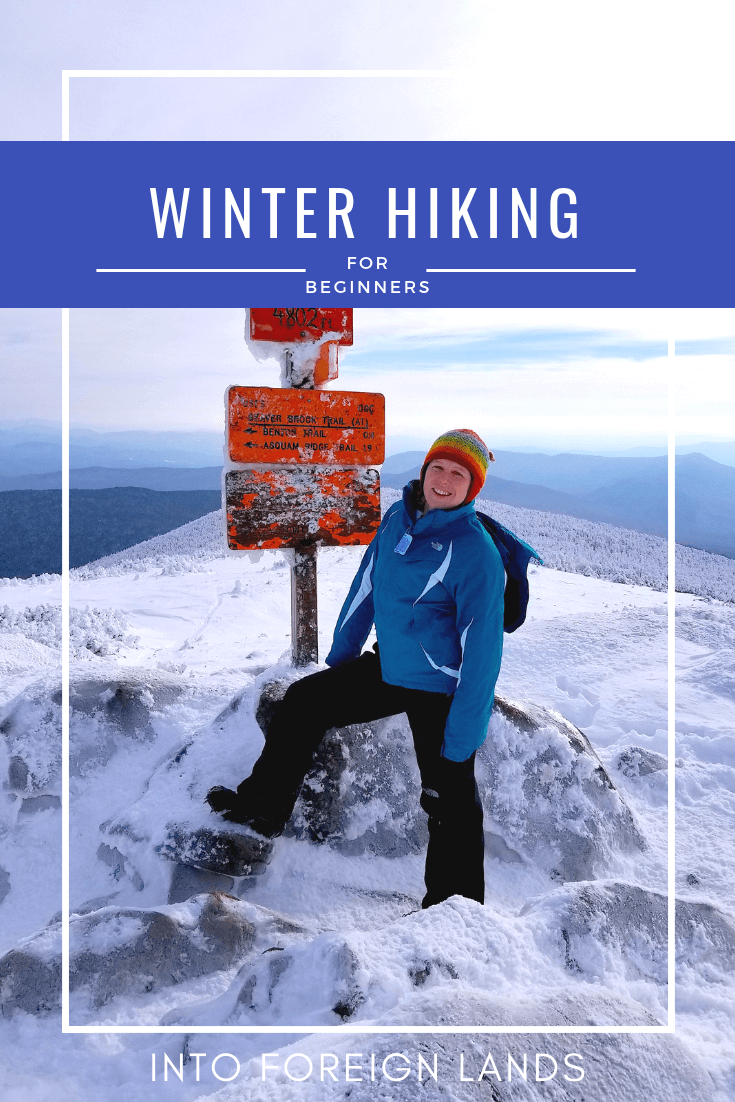

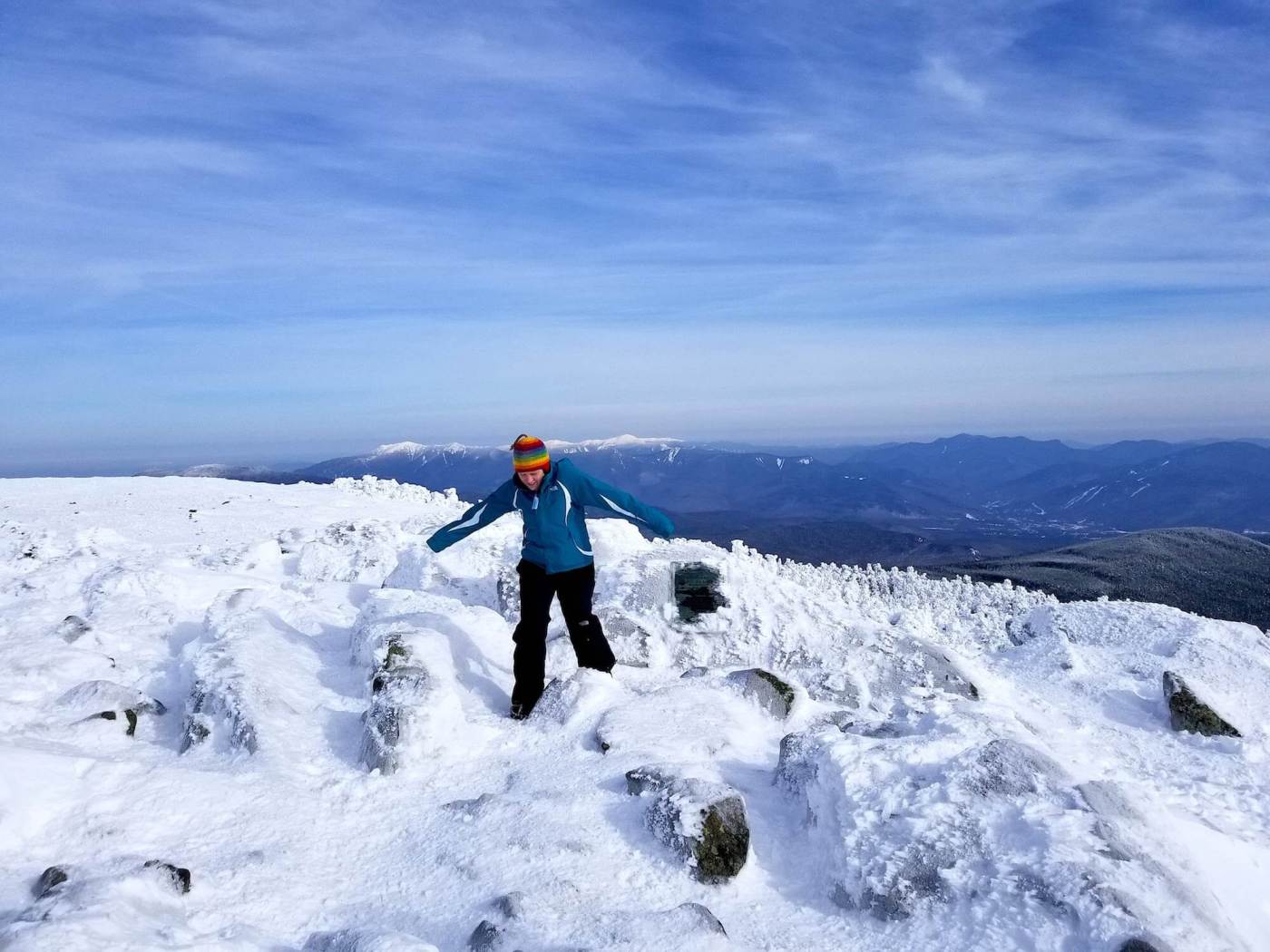

Fantastic post. I’m the same as you. I never ventured out to hike in the snow before last year, but it is soooo pretty. Now I blooming love it! 😀
LikeLike
I’m so hooked! I can’t believe I waited so long to try it.
LikeLiked by 1 person
Thank you for sharing! I agree- hiking in winter can be a volatile time, so it’s so important to be prepared! You have a lot of great tips here, but what are gaiters??
LikeLike
Good question! I guess I should explain. They are a waterproof later that wraps around your lower leg and hooks around your boot so that if you step into deep water your feet/legs won’t get wet.
LikeLike
I’m going to take your What to Wear list shopping. I clearly have been missing a lot of items that would help me be much warmer when hiking or snowshoeing. Totally agree that you shouldn’t hike alone also.
LikeLike
Yay! Having the right gear makes such a difference, especially on the cold descents.
LikeLike
Great post! I’ve just moved to Canada and wasn’t sure I’d be brave enough to get out hiking in the winter snow … I might now give it a go with your tips!
LikeLike
I put off winter hiking for years but honestly it might be my new favorite. It is such a cool way to experience winter.
LikeLike
This is great. I want to do some winter hiking myself and this was super clear and helpful. The hot water in the thermos and heat packs for your phone are excellent ideas I probably wouldn’t have thought of!
LikeLike
A friend clued me into those on my first winter hike, especially the heat pack by the phone. SUPER useful.
LikeLiked by 1 person
Winters in NYC feel like intense winter hiking – but wasn’t anything like what we experienced last February during out first trip to Iceland. Great tips for first timers hiking in that type of climate.
LikeLike
Thanks! Yeah, living in Boston just going out my front door in the winter can be intense. But doing it in the mountains makes it so much more enjoyable.
LikeLike
Thanks for this, I’ve been intimidated and I bought some books on winter survival/camping so I could learn a bit. It really overwhelmed me because they were recommending being REALLY prepared, like having an avalanche beacon etc. All told it sounded like way too much gear for me to physically carry. This is more succinct!
LikeLiked by 1 person
I think it depends where you are planning to go. If you’ll be in a zone with avalanche risk then yes it is wise to be overprepared (and go with someone more experienced!) but if you’re not in danger of avalanches, that’s one less thing to be worried about.
LikeLiked by 1 person
I did winter hiking for one week two years ago and truly enjoyed this outdoor activity and the opportunity to stroll around enchanting, white, landscapes. Reading your post, you are instilling in me the desire to try again next month when I will be on the slopes.
LikeLiked by 1 person
It is so great to walk through that winter wonderland. I loved it.
LikeLike
I’m not sure if you’ll believe that I’ve never gone hiking but should I ever want to give it a try these are some great tips!
LikeLiked by 1 person
Never been hiking!? Oh no! You should try… it’s such a wonderful way to spend a day. Maybe start during the summer though….
LikeLike
Ahh I so loved this post. I long to do stuff like this way out in the wilderness…..I have asthma, so I get very scared of what could happen from climate or air changes and no emergency services close…so I just don’t do it…makes me sad kinda.
Your pics are fabulous!
VAlerie
LikeLiked by 1 person
It does make sense to take care of your health first. Maybe try to find other people who struggle with asthma and see how they handle it? It could still be possible for you to go on shorter/safer excursions! But I am not a doctor so definitely do not make decisions based on what I say…
LikeLike
EEK you’re a brave sole! I love easy winter walks – it’s just so pretty. But not sure I’m ready to hike in all the layers and extra stuff you have to carry. Loving the tips though!
LikeLiked by 1 person
Build up to it! I thought I would hate winter hiking for years and years so I never tried it. Maybe start with shorter winter walks or winter snowshoe trips?
LikeLike
Oh, I’d love to try some winter hiking! I live in Hawaii so 1) there’s no snow (except a little on the Big Island), and 2) when I do go to places with snow I never have the right shoes unfortunately. It’s not like we’d buy them just to use them once, haha. But will definitely keep this one in mind if I have the chance (and shoes!) to do a winter hike.
LikeLiked by 1 person
I had no idea the big island ever got a little snow! That’s wild. Having the gear can be the biggest detractor from going on adventures, its true. You could always look for places to rent.
LikeLike
The views look stunning on your pictures and I enjoyed reading this. We’re in the UK so the snow and cold aren’t quite as bad as in the USA but even so, there are some very useful tips here. Thank you!
LikeLiked by 1 person
I just discovered snowshoes a month ago and they definitey made a difference! These photos are so stunning and I agree with all of the advice. Thanks for sharing!
LikeLike
I should take up winter hiking for the beautiful sights! I’ve never done it.
LikeLike
I enjoyed your blog and can’t wait to try my first winter hike in the Smokies! I hike a lot around my home in Michigan but it’s not usually too challenging. Thank you for a nicely written, informational blog for outdoor enthusiasts!!
LikeLiked by 1 person
Glad it was helpful! Good luck on your first winter hike, stay safe!
LikeLiked by 2 people
My favorite part of hiking in the winter is when it’s 40 degrees Fahrenheit and you think it’s some warm out as opposed to 14 Fahrenheit.
LikeLike
Just discovered your post! Great advice! One thing I always forget is sunglasses/goggles. Sunglasses seem like such a warm weather accessory – but they are absolutely needed for the winter! Thanks for posting!
LikeLike
Love this! I took an REI Mountaineering class when I first wanted to learn snow skills.
LikeLike
Great idea! Classes are always a good way to know that you’re building the right skills. I’m hoping to get my AIARE 1 next season.
LikeLike
Finally someone answers my many questions! Thank you very much!
LikeLike